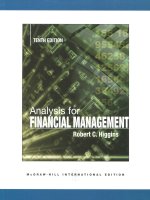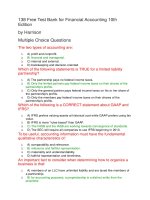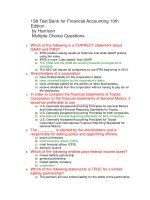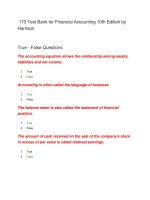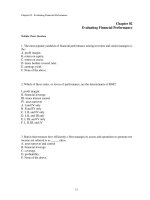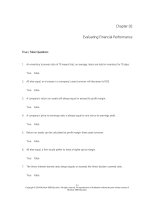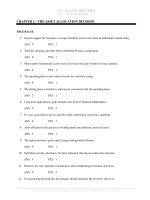Analysis for financial management 10th edition higgins test bank
Bạn đang xem bản rút gọn của tài liệu. Xem và tải ngay bản đầy đủ của tài liệu tại đây (1.11 MB, 22 trang )
Chapter 02 - Evaluating Financial Performance
Chapter 02
Evaluating Financial Performance
Multiple Choice Questions
1. The most popular yardstick of financial performance among investors and senior managers is
the:
A. profit margin.
B. return on equity.
C. return on assets.
D. times burden covered ratio.
E. earnings yield.
F. None of the above.
2. Which of these ratios, or levers of performance, are the determinants of ROE?
I. profit margin
II. financial leverage
III. times interest earned
IV. asset turnover
A. I and IV only
B. II and IV only
C. I, II, and IV only
D. I, II, and III only
E. I, III, and IV only
F. I, II, III, and IV
3. Ratios that measure how efficiently a firm manages its assets and operations to generate net
income are referred to as _____ ratios.
A. asset turnover and control
B. financial leverage
C. coverage
D. profitability
E. None of the above.
2-1
Chapter 02 - Evaluating Financial Performance
4. Which of the following ratios are measures of a firm's liquidity?
I. fixed asset turnover ratio
II. current ratio
III. debt-equity ratio
IV. acid test
A. I and III only
B. II and IV only
C. III and IV only
D. I, II, and III only
E. I, III, and IV only
5. Ptarmigan Travelers had sales of $420,000 in 2010 and $480,000 in 2011. The firm's current
accounts remained constant. Given this information, which one of the following statements
must be true?
A. The total asset turnover rate increased.
B. The days' sales in receivables increased.
C. The inventory turnover rate increased.
D. The fixed asset turnover decreased.
E. The collection period decreased.
6. Which one of the following ratios identifies the amount of assets a firm needs in order to
generate $1 in sales?
A. current ratio
B. debt-to-equity
C. retention
D. asset turnover
E. return on assets
2-2
Chapter 02 - Evaluating Financial Performance
7. Assume you are a banker who has loaned money to a firm, but that firm is now facing
increased competition and reduced cash flows. Which one of the following ratios would you
most closely monitor to evaluate the firm's ability to repay its loan?
A. current ratio
B. debt-to-equity ratio
C. times interest earned ratio
D. times burden covered ratio
E. None of the above.
8. Breakers Bay Inc. has succeeded in increasing the amount of goods it sells while holding the
amount of inventory on hand at a constant level. Assume that both the cost per unit and the
selling price per unit also remained constant. All else held constant, how will this
accomplishment be reflected in the firm's financial ratios?
A. decrease in the fixed asset turnover rate
B. decrease in the financial leverage ratio
C. increase in the inventory turnover rate
D. increase in the day's sales in inventory
E. no change in the total asset turnover rate
9. Which one of the following statements is correct?
A. If the debt-to-assets ratio is greater than 0.50, then the debt-to-equity ratio must be less than
1.0.
B. Long-term creditors would prefer the times interest earned ratio be 1.4 rather than 1.5.
C. The assets-to-equity ratio can be computed as 1 plus the debt-to-equity ratio.
D. To realize the best risk and reward profile, financial leverage should be maximized.
E. None of the above is correct.
10. On a common-size balance sheet, all accounts are expressed as a percentage of:
A. sales for the period.
B. the base year sales.
C. total equity for the base year.
D. total assets for the current year.
E. total assets for the base year.
2-3
Chapter 02 - Evaluating Financial Performance
11. Which one of the following statements does NOT describe a problem with using ROE as a
performance measure?
A. ROE measures return on accounting book value, and this problem is not solved by using
market value.
B. ROE is a forward-looking, one-period measure, while business decisions span the past and
present.
C. ROE measures only return, while financial decisions involve balancing risk against return.
D. None of these describe problems with ROE.
E. All of these describe problems with ROE.
Selected financial data for Link, Inc. follows: ($ in thousands)
2-4
Chapter 02 - Evaluating Financial Performance
12. The current ratio at the end of 2012 is:
A. 10.21
B. 2.31
C. 2.76
D. 10.30
E. None of the above.
13. Which of the following statements best describes how the company's short-term liquidity
changed from 2011 to 2012?
A. Link's short-run liquidity has improved modestly.
B. Link's short-run liquidity has deteriorated very little, but from a low initial base.
C. Link's short-run liquidity has improved considerably, but from a low initial base.
D. Link's short-run liquidity has deteriorated considerably, but from a high initial base.
E. None of the above.
14. Assume a 365-day year for your calculations. The collection period in days, based on sales,
at the end of 2012 is:
A. 24.3
B. 219.6
C. 35.7
D. 28.8
E. None of the above.
15. Assume a 365-day year for your calculations. The inventory turnover, based on cost of
goods sold, at the end of 2012 is:
A. 5.2
B. 24.3
C. 28.8
D. 35.7
E. None of the above.
2-5
Chapter 02 - Evaluating Financial Performance
16. Assume a 365-day year for your calculations. The payables period in days, based on cost of
goods sold, at the end of 2012 is:
A. 5.2
B. 24.3
C. 28.8
D. 35.7
E. None of the above.
17. Assume a 365-day year for your calculations. The days' sales in cash at the end of 2012 is:
A. 24.3
B. 28.8
C. 35.7
D. 219.6
E. None of the above.
18. The gross margin for 2012 is:
A. -94%
B. 13%
C. 26%
D. 31%
E. None of the above.
19. The profit margin for 2012 is:
A. -94%
B. -57%
C. 13%
D. 31%
E. None of the above.
2-6
Chapter 02 - Evaluating Financial Performance
Short Answer Questions
20. Answer the questions below based on the following information. Taxes are 35% and all
dollars are in millions.
a) Calculate each company's ROE, ROA, and ROIC.
b) Why is Runrun's ROE so much higher than Suunto's? Does this mean Runrun is a better
company? Why or why not?
c) Why is Suunto's ROA higher than Runrun's? What does this tell you about the two
companies?
d) How do the two companies' ROICs compare? What does this suggest about the two
companies?
2-7
Chapter 02 - Evaluating Financial Performance
The financial statements for Limited Brands, Inc. follow (fiscal years ending January):
2-8
Chapter 02 - Evaluating Financial Performance
21. Use Limited Brands, Inc.'s financial statements, above, to answer the following question.
Use the company's operating profit as an approximation of its EBIT, and assume a 40% tax rate
for your calculations. For the fiscal years ending in January of 2006 and 2007, calculate:
a) Limited Brands' total liabilities-to-equity ratio;
b) Times interest earned ratio; and
c) Times burden covered.
22. Use Limited Brands, Inc.'s financial statements, above, to answer the following question.
Use the company's operating profit as an approximation of its EBIT, and assume a 40% tax rate
for your calculations. What percentage decline in earnings before interest and taxes could
Limited Brands have sustained in fiscal years 2006 and 2007 before failing to cover:
a) Interest and principal repayment requirements;
b) Interest, principal and common dividend payments?
23. Use Limited Brands, Inc.'s financial statements, above, to prepare common-size financial
statements for Limited Brands, Inc. for 2006 - 2007.
2-9
Chapter 02 - Evaluating Financial Performance
Chapter 02 Evaluating Financial Performance Answer Key
Multiple Choice Questions
1. The most popular yardstick of financial performance among investors and senior managers is
the:
A. profit margin.
B. return on equity.
C. return on assets.
D. times burden covered ratio.
E. earnings yield.
F. None of the above.
Difficulty: 1 Easy
2. Which of these ratios, or levers of performance, are the determinants of ROE?
I. profit margin
II. financial leverage
III. times interest earned
IV. asset turnover
A. I and IV only
B. II and IV only
C. I, II, and IV only
D. I, II, and III only
E. I, III, and IV only
F. I, II, III, and IV
Difficulty: 2 Medium
2-10
Chapter 02 - Evaluating Financial Performance
3. Ratios that measure how efficiently a firm manages its assets and operations to generate net
income are referred to as _____ ratios.
A. asset turnover and control
B. financial leverage
C. coverage
D. profitability
E. None of the above.
Difficulty: 1 Easy
4. Which of the following ratios are measures of a firm's liquidity?
I. fixed asset turnover ratio
II. current ratio
III. debt-equity ratio
IV. acid test
A. I and III only
B. II and IV only
C. III and IV only
D. I, II, and III only
E. I, III, and IV only
Difficulty: 1 Easy
5. Ptarmigan Travelers had sales of $420,000 in 2010 and $480,000 in 2011. The firm's current
accounts remained constant. Given this information, which one of the following statements
must be true?
A. The total asset turnover rate increased.
B. The days' sales in receivables increased.
C. The inventory turnover rate increased.
D. The fixed asset turnover decreased.
E. The collection period decreased.
Difficulty: 2 Medium
2-11
Chapter 02 - Evaluating Financial Performance
6. Which one of the following ratios identifies the amount of assets a firm needs in order to
generate $1 in sales?
A. current ratio
B. debt-to-equity
C. retention
D. asset turnover
E. return on assets
Difficulty: 1 Easy
7. Assume you are a banker who has loaned money to a firm, but that firm is now facing
increased competition and reduced cash flows. Which one of the following ratios would you
most closely monitor to evaluate the firm's ability to repay its loan?
A. current ratio
B. debt-to-equity ratio
C. times interest earned ratio
D. times burden covered ratio
E. None of the above.
The times burden covered ratio is the best answer, as it indicates how well the firm's cash flows
cover both debt principal and interest payments. The times interest earned ratio applies most
appropriately when we are confident the firm can roll over existing debt; this is not the case
here.
Difficulty: 1 Easy
8. Breakers Bay Inc. has succeeded in increasing the amount of goods it sells while holding the
amount of inventory on hand at a constant level. Assume that both the cost per unit and the
selling price per unit also remained constant. All else held constant, how will this
accomplishment be reflected in the firm's financial ratios?
A. decrease in the fixed asset turnover rate
B. decrease in the financial leverage ratio
C. increase in the inventory turnover rate
D. increase in the day's sales in inventory
E. no change in the total asset turnover rate
Difficulty: 2 Medium
2-12
Chapter 02 - Evaluating Financial Performance
9. Which one of the following statements is correct?
A. If the debt-to-assets ratio is greater than 0.50, then the debt-to-equity ratio must be less than
1.0.
B. Long-term creditors would prefer the times interest earned ratio be 1.4 rather than 1.5.
C. The assets-to-equity ratio can be computed as 1 plus the debt-to-equity ratio.
D. To realize the best risk and reward profile, financial leverage should be maximized.
E. None of the above is correct.
Difficulty: 2 Medium
10. On a common-size balance sheet, all accounts are expressed as a percentage of:
A. sales for the period.
B. the base year sales.
C. total equity for the base year.
D. total assets for the current year.
E. total assets for the base year.
Difficulty: 1 Easy
11. Which one of the following statements does NOT describe a problem with using ROE as a
performance measure?
A. ROE measures return on accounting book value, and this problem is not solved by using
market value.
B. ROE is a forward-looking, one-period measure, while business decisions span the past and
present.
C. ROE measures only return, while financial decisions involve balancing risk against return.
D. None of these describe problems with ROE.
E. All of these describe problems with ROE.
Difficulty: 2 Medium
2-13
Chapter 02 - Evaluating Financial Performance
Selected financial data for Link, Inc. follows: ($ in thousands)
12. The current ratio at the end of 2012 is:
A. 10.21
B. 2.31
C. 2.76
D. 10.30
E. None of the above.
Difficulty: 1 Easy
2-14
Chapter 02 - Evaluating Financial Performance
13. Which of the following statements best describes how the company's short-term liquidity
changed from 2011 to 2012?
A. Link's short-run liquidity has improved modestly.
B. Link's short-run liquidity has deteriorated very little, but from a low initial base.
C. Link's short-run liquidity has improved considerably, but from a low initial base.
D. Link's short-run liquidity has deteriorated considerably, but from a high initial base.
E. None of the above.
Difficulty: 2 Medium
14. Assume a 365-day year for your calculations. The collection period in days, based on sales,
at the end of 2012 is:
A. 24.3
B. 219.6
C. 35.7
D. 28.8
E. None of the above.
Difficulty: 2 Medium
15. Assume a 365-day year for your calculations. The inventory turnover, based on cost of
goods sold, at the end of 2012 is:
A. 5.2
B. 24.3
C. 28.8
D. 35.7
E. None of the above.
Difficulty: 2 Medium
2-15
Chapter 02 - Evaluating Financial Performance
16. Assume a 365-day year for your calculations. The payables period in days, based on cost of
goods sold, at the end of 2012 is:
A. 5.2
B. 24.3
C. 28.8
D. 35.7
E. None of the above.
Difficulty: 2 Medium
17. Assume a 365-day year for your calculations. The days' sales in cash at the end of 2012 is:
A. 24.3
B. 28.8
C. 35.7
D. 219.6
E. None of the above.
Difficulty: 2 Medium
18. The gross margin for 2012 is:
A. -94%
B. 13%
C. 26%
D. 31%
E. None of the above.
Difficulty: 1 Easy
19. The profit margin for 2012 is:
A. -94%
B. -57%
C. 13%
D. 31%
E. None of the above.
Difficulty: 1 Easy
2-16
Chapter 02 - Evaluating Financial Performance
Short Answer Questions
20. Answer the questions below based on the following information. Taxes are 35% and all
dollars are in millions.
a) Calculate each company's ROE, ROA, and ROIC.
b) Why is Runrun's ROE so much higher than Suunto's? Does this mean Runrun is a better
company? Why or why not?
c) Why is Suunto's ROA higher than Runrun's? What does this tell you about the two
companies?
d) How do the two companies' ROICs compare? What does this suggest about the two
companies?
2-17
Chapter 02 - Evaluating Financial Performance
a.
b. Runrun's higher ROE is a natural reflection of its higher financial leverage. It does not mean
that Runrun is the better company.
c. This is also due to Runrun's higher leverage. ROA penalizes levered companies by
comparing the net income available to equity to the capital provided by owners and creditors. It
does not mean that Runrun is a worse company than Suunto.
d. ROIC abstracts from differences in leverage to provide a direct comparison of the earning
power of the two companies' assets. On this metric, Suunto is the superior performer. Before
drawing any firm conclusions, however, it is important to ask how the business risks faced by
the companies compare and whether the observed ratios reflect long-run capabilities or
transitory events.
Difficulty: 2 Medium
2-18
Chapter 02 - Evaluating Financial Performance
The financial statements for Limited Brands, Inc. follow (fiscal years ending January):
2-19
Chapter 02 - Evaluating Financial Performance
21. Use Limited Brands, Inc.'s financial statements, above, to answer the following question.
Use the company's operating profit as an approximation of its EBIT, and assume a 40% tax rate
for your calculations. For the fiscal years ending in January of 2006 and 2007, calculate:
a) Limited Brands' total liabilities-to-equity ratio;
b) Times interest earned ratio; and
c) Times burden covered.
Difficulty: 2 Medium
2-20
Chapter 02 - Evaluating Financial Performance
22. Use Limited Brands, Inc.'s financial statements, above, to answer the following question.
Use the company's operating profit as an approximation of its EBIT, and assume a 40% tax rate
for your calculations. What percentage decline in earnings before interest and taxes could
Limited Brands have sustained in fiscal years 2006 and 2007 before failing to cover:
a) Interest and principal repayment requirements;
b) Interest, principal and common dividend payments?
(Note that principal payment in year t equals current portion of long-term debt in year t-1.)
Difficulty: 2 Medium
2-21
Chapter 02 - Evaluating Financial Performance
23. Use Limited Brands, Inc.'s financial statements, above, to prepare common-size financial
statements for Limited Brands, Inc. for 2006 - 2007.
Difficulty: 2 Medium
2-22
